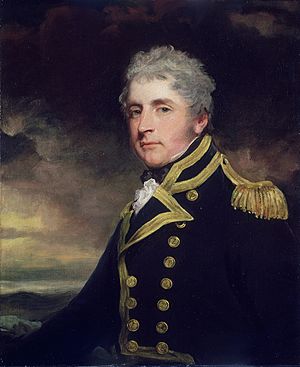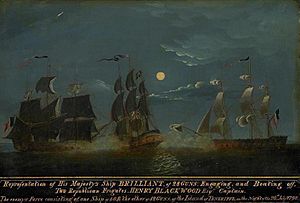Henry Blackwood facts for kids
Quick facts for kids
Sir Henry Blackwood, Bt
|
|
|---|---|

Sir Henry Blackwood
|
|
| Born | 28 December 1770 Ballyleidy (later renamed Clandeboye), County Down |
| Died | 17 December 1832 (aged 61) Ballyleidy (later renamed Clandeboye), County Down |
| Allegiance | |
| Service/ |
|
| Years of service | 1781–1830 |
| Rank | Vice Admiral |
| Commands held | HMS Nonsuch HMS Brilliant HMS Penelope HMS Euryalus Ajax Warspite East Indies Station Nore Command |
| Battles/wars | Fourth Anglo-Dutch War French Revolutionary Wars Napoleonic Wars |
| Awards | Knight Grand Cross of the Royal Guelphic Order Knight Commander of the Order of the Bath |
Sir Henry Blackwood (born December 28, 1770 – died December 17, 1832) was a brave Irish officer in the British Royal Navy. He became a Vice-Admiral, which is a very high rank. He was also given the special title of 1st Baronet. His memorial can be found in Killyleagh Parish Church.
Contents
Henry Blackwood was born in Ballyleidy, which is now called Clandeboye, in County Down. He was the fourth son of Sir John Blackwood.
In April 1781, when he was just 10 years old, Henry joined the Royal Navy. He started as a volunteer on a ship called HMS Artois. On this ship, he took part in his first battle, the Battle on the Dogger Bank.
Adventures with Frigates
Henry Blackwood quickly moved up the ranks. He became a lieutenant, then a commander, and finally a post captain. A captain is the person in charge of a ship.
HMS Brilliant and a Daring Escape
From 1795 to 1796, he was captain of HMS Nonsuch. After that, he took command of a 28-gun frigate called HMS Brilliant. A frigate is a fast, medium-sized warship.
In 1798, Brilliant was near Santa Cruz de Tenerife. Two French frigates, Vertu and Régénérée, were getting ready to sail. On July 26, the French ships began firing at Brilliant. The Régénérée tried to get closer, but it lost part of its mast and bowsprit. This allowed Brilliant to escape. The Vertu chased Brilliant but couldn't catch her.
Blockading Malta with HMS Penelope
In 1799, Blackwood became captain of HMS Penelope, a 36-gun frigate. He was sent to the Mediterranean Sea. For several months, he helped to blockade Malta. This meant his ship stayed close to the island to stop other ships from entering or leaving.
On March 30, 1800, a large French warship called Guillaume Tell (80 guns) tried to sneak out of the harbor at night. Even though Penelope was much smaller, Blackwood bravely followed. He used his ship's speed to attack Guillaume Tell from different angles. He fired his cannons from the side of his ship, causing a lot of damage.
By daylight, the Guillaume Tell was badly damaged. Soon, two larger British ships, Lion and Foudroyant, arrived. The Guillaume Tell had to surrender. Everyone agreed that Penelope's brave actions were key to stopping the much larger French ship.
Lord Nelson, a very famous British admiral, wrote to Blackwood. He praised Blackwood's "glorious" actions and said his fame was "beyond the reach of envy."
Working with Nelson on HMS Euryalus
In April 1803, Blackwood took command of Euryalus, another 36-gun frigate. For the next two years, he patrolled the coast of Ireland and the English Channel.
The Road to Trafalgar
In July 1805, he was sent to watch the French fleet after a battle. He brought back news that the French fleet had gone to Cadiz. He then met with Lord Nelson, who was given command of the British fleet. Blackwood, in Euryalus, went with Nelson to Cadiz. He was put in charge of the ships closest to the enemy. His job was to tell Nelson about every move the French made.
Blackwood was offered a larger "line-of-battle" ship, but he chose to stay on Euryalus. He thought he would have more chances to show his skill on the smaller ship. He was sure the French would not leave port while Nelson was there.
The Battle of Trafalgar
On the morning of the Battle of Trafalgar (October 21, 1805), Blackwood was on Nelson's flagship, Victory. He stayed there even as cannonballs flew around them. Nelson gave Blackwood his final orders. He also made Blackwood promise to take care of his family. Nelson then told Blackwood to return to his ship. "God bless you, Blackwood," Nelson said, shaking his hand. "I shall never speak to you again."
Nelson gave Blackwood command of all the frigates. Blackwood's job was to help any damaged British ships. He also had special permission to use Nelson's name to order other ships to help.
After the battle, Admiral Collingwood briefly used Euryalus as his flagship. Then, Euryalus was sent back to England with important messages and the captured French admiral. Blackwood was one of the first to deliver the news of the victory to London. He also helped at Lord Nelson's funeral.
The Fire on HMS Ajax
In 1807, Blackwood was captain of Ajax. His ship was in the Dardanelles (a narrow sea passage). Sadly, Ajax accidentally caught fire. This was a terrible tragedy, and 252 lives were lost. Blackwood survived by holding onto an oar in the water for an hour before being rescued.
Commanding HMS Warspite
After a formal investigation, Blackwood was cleared of any blame for the Ajax fire. He was then given command of Warspite. His nephew, Price Blackwood, was one of the young officers on board.
Blackwood sailed Warspite in the North Sea and with the Channel Fleet. He commanded a small group of ships during the blockade of Toulon in 1810. He continued to serve on Warspite until 1813.
One of his young officers described Blackwood as a strict captain. He seemed to order punishments almost every day. Blackwood eventually resigned his command after a disagreement with another admiral.
Becoming a Rear-Admiral
On June 4, 1814, Blackwood was promoted to rear-admiral. In September, he was given the title of Baronet for helping to bring European royal families to England after Napoleon's defeat.
In 1819, he became a Knight Companion of the Order of the Bath. He was then appointed commander-in-chief of the East Indies Station. This meant he was in charge of all British naval forces in the East Indies. He returned from this duty in December 1822.
He became a vice-admiral in May 1825. From 1827 to 1830, he was in charge of the Nore Command. During this time, he lived in London.
Later Life and Legacy
From 1830 until his death, he worked for King William IV.
Sir Henry Blackwood passed away on December 17, 1832, after a short illness. He was buried in Westminster Abbey in London.
He was married three times and had a large family.
The Blackwood River in Western Australia is named after him. It was named by Captain James Stirling, who served under Blackwood when he was young. The Blackwood region in Adelaide, South Australia, was also named by William Light, who served with him during the Napoleonic Wars.
Images for kids



